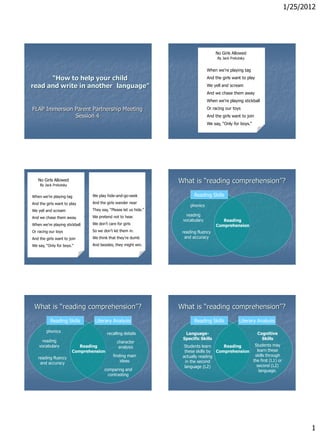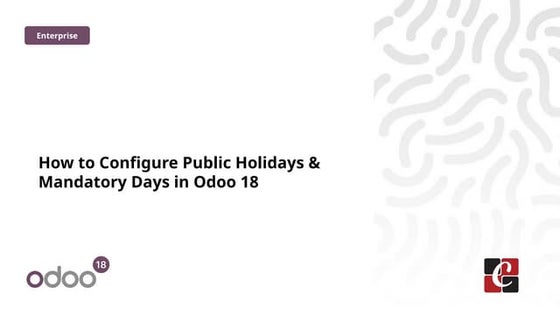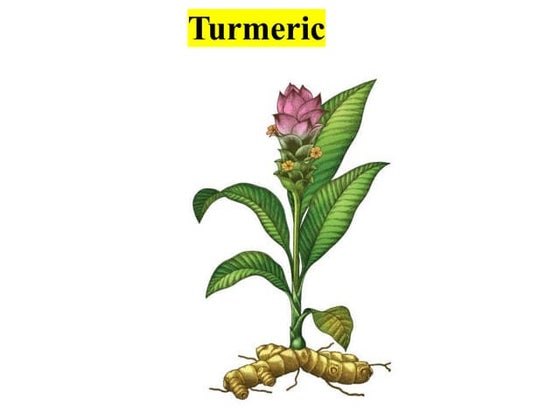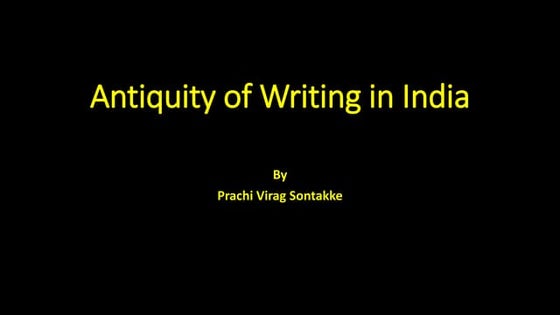Strengthening tl literacy
- 1. 1/25/2012 No Girls Allowed By Jack Prelutsky When we?re playing tag ¡°How to help your child And the girls want to play read and write in another language" We yell and scream And we chase them away When we?re playing stickball FLAP Immersion Parent Partnership Meeting Or racing our toys Session 4 And the girls want to join We say, ¡°Only for boys.¡± No Girls Allowed By Jack Prelutsky What is ¡°reading comprehension¡±? When we?re playing tag We play hide-and-go-seek Reading Skills And the girls want to play And the girls wander near phonics We yell and scream They say, ¡°Please let us hide.¡± We pretend not to hear. reading And we chase them away. vocabulary Reading When we?re playing stickball We don?t care for girls Comprehension Or racing our toys So we don?t let them in. reading fluency And the girls want to join We think that they?re dumb and accuracy We say, ¡°Only for boys.¡± And besides, they might win. What is ¡°reading comprehension¡±? What is ¡°reading comprehension¡±? Reading Skills Literary Analysis Reading Skills Literary Analysis phonics recalling details Language- Cognitive Specific Skills Skills reading character vocabulary Reading analysis Students learn Reading Students may Comprehension these skills by Comprehension learn these finding main actually reading skills through reading fluency ideas in the second the first (L1) or and accuracy language (L2) second (L2) comparing and language. contrasting 1
- 2. 1/25/2012 What is ¡°reading comprehension¡±? ¡°Two-Balloon Theory¡± Reading Skills Literary Analysis Those who are against bilingual Language Cognitive What I What I education have Specific Skills Skills learned learned argued that Students learn Reading Students may in L1 in L2 learning in these skills by Comprehension learn these actually reading skills through child?s L1 limits in the second the first (L1) or his/her exposure language (L2) second (L2) to the L2 and language. inhibits its acquisition. ¡°Common Underlying ¡°Common Underlying Proficiency¡± Proficiency¡± ¡°Common Underlying Proficiency (CUP)¡± is the notion that the surface surface knowledge of content learned in one features features language can be transferred to a of L1 of L2 second language. CUP ¡°makes possible the transfer of cognitive/academic or literacy-related skills across languages¡± (Cummins, 1992 p. 22) ¡°Common Underlying Proficiency¡± ¡°One-Balloon Theory¡± Proficiencies that What I What I involve more surface surface learned learned cognitively features features in L1 in L2 demanding tasks of L1 of L2 (ex. Literacy, content learning, problem-solving) Common Underlying Proficiency are common across languages. 2
- 3. 1/25/2012 Learning how to Advantages of Literacy Development through Home Language (L1) use a can opener ? Faster development of L2 proficiency (Collier, 1995) ? Nurture the ability to process cognitively demanding academic tasks through the fully developed language system (L1) ? Preservation of both L1 and L2 through additive bilingualism ¡°Literacy Analysis¡± Tasks Language Immersion Education for Recalling information (when, where, who, what, how) Native Spanish/Japanese Speakers Sequence (recalling the story events in order) Character Analysis (describe the characters in reference to ? Promotes the use of minority languages in their words, actions, etc.) school context Compare and Contrast (characters, story to another story, ? Provides transition into English (L2) etc.) without losing home language (L1) Inference (finding things not directly stated in the text through context clues) ? Provides supportive socio-cultural context Personal Connections (connecting the reader to the text in with the perception of bilingualism as personal ways) enrichment rather than remedial Predictions (finding what is going to happen next in the story) Summary (Sum up the main ideas/details of the story) Step 1: ¡°Determine your child¡¯s reading level¡± Step 1: ¡°Determine your child¡¯s reading level¡± A. If your child is not able to read at all, you B. If your child is able to follow the print, you read the text and then ask questions. Your child read the text, and your child should follow your should respond to the questions orally. reading with his/her eyes on the pages. You then ask questions, and your child should respond to them orally. 3
- 4. 1/25/2012 Step 1: ¡°Determine your child¡¯s reading level¡± Step 2: ¡°How to select the reading text¡± C. If your child can read independently, he/she A. Even if your child is not able to read at all, should read the text. Then, at the appropriate still make sure your child can understand and moment, you stop your child and ask questions. enjoy the story. Your child should respond to the questions orally. Step 2: ¡°How to select the reading text¡± Step 3: ¡°This is NOT leisurely reading time.¡± B. ¡°90-10 Rule¡± ? Your child should be informed BEFOREHAND that this reading time is NOT going to be his/her If your child is able to follow the print, or he/she leisurely reading time. can read independently, roughly 90% of the text should be understandable for your child. To ? Make your intentions clear to your child that this check this, you or your child should try reading reading time is for you to help him/her beter the first page of the book. If your child understand what he/she is reading. consistently mispronounce or is not able read 1 ? Your child should have uninterrupted, leisurely word out of every 10 words, the book may be reading time as well. too difficult for your child to enjoy. ¡°Literacy Analysis¡± Tasks Step 4: ¡°Establish reward system.¡± Recalling information (when, where, who, what, how) Sequence (recalling the story events in order) ? It may be helpful to establish some kind of Character Analysis (describe the characters in reference to reward system to positively reinforce this their words, actions, etc.) structured home reading time. Compare and Contrast (characters, story to another story, ? Stickers on a calendar etc.) Inference (finding things not directly stated in the text ? Points recorded on a sheet of paper through context clues) ? Once the number of reading time reaches a Personal Connections (connecting the reader to the text in certain amount, your child may be rewarded personal ways) with frozen yogurt, an extracurricular activity, Predictions (finding what is going to happen next in the etc. story) Summary (Sum up the main ideas/details of the story) 4
- 5. 1/25/2012 No Girls Allowed Recalling information No Girls Allowed Sequence (recalling the story By Jack Prelutsky (when, where, who, what, By Jack Prelutsky events in order) how) ¡°Can you tell me the games When we?re playing tag ¡°Who is speaking in this When we?re playing tag that the boys played in And the girls want to play poem?¡± And the girls want to play order?¡± We yell and scream Answer: ¡°A boy.¡± We yell and scream Answer: ¡°Tag, stickball...¡± And we chase them away. ¡°What would boys do when And we chase them away. ¡°When did the boys say to When we?re playing stickball girls want to play with When we?re playing stickball the girls ?Only for boys??¡± them?¡± Or racing our toys Or racing our toys Possible Answer: ¡°When the Possible Answer: ¡°They yell girls wanted to join in playing And the girls want to join And the girls want to join and scream and chase them stickball or racing the toys.¡± We say, ¡°Only for boys.¡± away.¡± We say, ¡°Only for boys.¡± No Girls Allowed Character Analysis (describe No Girls Allowed Compare and Contrast By Jack Prelutsky the characters in reference to By Jack Prelutsky (characters, story to another their words, actions, etc.) story, etc.) When we?re playing tag ¡°Why do these boys chase When we?re playing tag ¡°How are these girls different the girls away?? from (similar to) the boys?¡± And the girls want to play And the girls want to play Possible Answer: ¡°The girls We yell and scream Possible Answer: ¡°Because We yell and scream they don?t want to play tag are nice, but the boys are And we chase them away. And we chase them away. mean.¡± with girls.¡± When we?re playing stickball When we?re playing stickball ¡°What do these boys have in ¡°How would you describe Or racing our toys these boys?¡± ¡°They are¡?¡± Or racing our toys common with the boys in the And the girls want to join And the girls want to join story Sand Lot?¡° Possible Answers: ¡°Not nice¡± We say, ¡°Only for boys.¡± ¡°Mean¡± ¡°Not friendly¡± We say, ¡°Only for boys.¡± Possible Answer: ¡°The boys ¡°Exclusive¡± in Sand Lot are nicer than these boys because¡¡± We play hide-and-go-seek Inference (finding things not We play hide-and-go-seek Personal Connections directly stated in the text (connecting the reader to the And the girls wander near through context clues) And the girls wander near text in personal ways) They say, ¡°Please let us They say, ¡°Please let us ¡°What would you do if you hide.¡± hide.¡± were in this group of boys?¡± ¡°Why did he say, ?¡and We pretend not to hear. besides, they might win?? We pretend not to hear. Possible Answer: ¡°I would What is the real reason for play with the girls because I these boys for not playing don?t care if they win or not.¡± We don?t care for girls We don?t care for girls with girls?¡± ¡°Do you sometimes feel like So we don?t let them in. So we don?t let them in. Possible Answer: ¡°Because this boy?¡± We think that they?re dumb they don?t want to lose to We think that they?re dumb Possible Answer: ¡°Yeah, And besides, they might girls.¡± And besides, they might sometimes I want to play win. win. only with boys because¡¡± 5
- 6. 1/25/2012 We play hide-and-go-seek Predictions (finding what is We play hide-and-go-seek Summary (summing up the going to happen next in the main topic and important And the girls wander near story) And the girls wander near details of the story in his/her They say, ¡°Please let us They say, ¡°Please let us own words) ¡°Do you think the boys will hide.¡± ever change their minds and hide.¡± ¡°Can you tell me in short We pretend not to hear. let the girls in on their play?¡± We pretend not to hear. what this story is all about?¡± Possible Answer: ¡°I don?t Possible Answer: ¡°This is a think the boys will ever let story of boys with feeble We don?t care for girls We don?t care for girls the girls in on their games masculinity and it displayed So we don?t let them in. because they already said no So we don?t let them in. itself in their resistance to We think that they?re dumb 3 times in the story. They We think that they?re dumb cooperate with the girls in a don?t like them.¡± mature manner.¡± And besides, they might And besides, they might win. win. Reading Skills (Kindergarten) Reading Skills (1st grade) (CA. content standards) (CA. content standards) ? Identify characters, settings, and important ? Identify text that uses sequence or other logical events. (recalling information) order. (sequencing) ? Confirm predictions about what will happen next ? Connect to life experiences the information and in a text by identifying key words (i.e., signpost events in texts. (personal connections) words). (predictions) ? Retell familiar stories. (recalling information) ? Respond to who, what, when, where, and how questions. (recalling information) ? Ask and answer questions about essential ? Identify and describe the elements of plot, elements of a text. setting, and character(s) in a story, as well as the story's beginning, middle, and ending. (recalling information, sequencing) Reading Skills (2nd grade) Reading Skills (3rd grade) (CA. content standards) (CA. content standards) ? Restate facts and details in the text to clarify ? Recall major points in the text and make and and organize ideas. (recalling details) modify predictions about forthcoming ? Compare and contrast plots, settings, and information. (recalling details, prediction) characters presented by different authors. ? Follow simple multiple-step written instructions (compare and contrast) (sequence) ? Compare and contrast different versions of the ? Determine what characters are like by what they same stories that reflect different cultures. say or do and by how the author or illustrator (compare and contrast) portrays them. (character analysis) 6
- 7. 1/25/2012 Reading Skills (4th grade) Reading Skills (5th grade) (CA. content standards) (CA. content standards) ? Compare and contrast information on the same ? Draw inferences, conclusions, or generalizations topic after reading several passages or articles. about text and support them with textual (compare and contrast) evidence and prior knowledge. (inference, ? Follow multiple-step instructions in a basic personal connections) technical manual (sequence) ? Identify the main problem or conflict of the plot ? Use knowledge of the situation and setting and and explain how it is resolved. (recalling of a character's traits and motivations to information) determine the causes for that character's ? Contrast the actions, motives (e.g., loyalty, actions. (character analysis) selfishness, conscientiousness), and ? Compare and contrast tales from different appearances of characters in a work of fiction cultures by tracing the exploits of one character and discuss the importance of the contrasts to type and develop theories to account for similar the plot or theme. (character analysis, compare tales in diverse cultures (compare and contrast) and contrast) Transferable and non-transferable items ¡°Common Underlying Proficiency¡± across Letter-sound connection Non-transferable Word languages (selected items) Transferable Vocabulary Knowledge Meaningfulness of print Language-specific word Synonyms/Antonyms structure surface surface Multiple-meaning words features features Reading Text structures Print directionality of L1 of L2 Comp. Word recognition skills Story structure and Reading strategies rhetorical devices. Writing Text structures Grammar features Writing domains Spelling features Writing strategies Meta- Habits and attitudes Cultural schema cognitive toward reading and Skills writing ¡°Common Underlying Proficiency¡± ¡°One-Balloon Theory¡± Proficiencies that What I What I involve more surface surface learned learned cognitively features features in L1 in L2 demanding tasks of L1 of L2 (ex. Literacy, content learning, problem-solving) Common Underlying Proficiency are common across languages. 7
- 8. 1/25/2012 What is ¡°reading comprehension¡±? What about other reading skills? Reading Skills Literary Analysis ? Language of encouragement and support ? Facilitate occasions for reading/writing in phonics recalling details Spanish/Japanese ? Obtain books in Spanish/Japanese reading character vocabulary Reading ? Spark students? interests (¡°Dora the Explorer,¡± ¡°Go, analysis Comprehension Diego, Go!¡± Pokemon, anime, popular English books finding main translated into Spanish/Japanese etc.) reading fluency and accuracy ideas ? Connect and extend your child?s learning in classroom comparing and ? Study buddies (e.g., homework, play dates) contrasting ? Technology-enhanced activities Summary Thank you for participating! ¡°How to help my child read/write in another language¡± ? We look forward to seeing you at the next Immersion Parent Partner session! ? Establish independent and on-going Session £µ: Wednesday, February 15 reading/writing routines in home language ¡°Straight-talk: parent-to-parent Sync home reading/writing routines to current ? immersion forum¡± reading/writing lessons whenever possible Question and answer sessions with the panel of (Source: English Language Arts Common Core experienced immersion parents ! State Standards: http://www.cde.ca.gov/ci/cc/) Topics include: ? Open to the opportunities for native peer ¡°How can I support my child go through immersion education?¡± support ¡°How can I support my child?s teacher/school?¡± ¡°How can I support (or advocate for) immersion programs in the ? Take advantage of engagement that technology district?¡± provides 8
















































